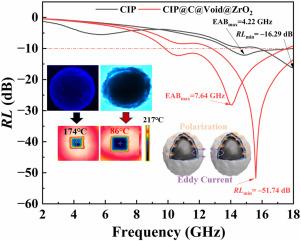Lightweight carbonyl iron powder-based yolk-shell architectures for integrated electromagnetic wave absorption and thermal protection
IF 11.6
2区 材料科学
Q1 CHEMISTRY, PHYSICAL
引用次数: 0
Abstract
The rapid development of 5G mobile communication and the increasing integration density of electronic devices pose serious challenges to electromagnetic interference control. Carbonyl iron powder (CIP), a widely used magnetic absorber, suffers from high density, limited oxidation resistance, and a narrow effective absorption bandwidth (EAB) under low filler content (60 wt%). In this work, a CIP-based yolk-shell composite structure (CIP@C@Void@ZrO2) is designed using a sol-gel-hydrothermal-etching approach, which enables a dielectric architecture with multiple heterogeneous interfaces. The resulting material achieves a minimum reflection loss (RLmin) of −51.74 dB at a thickness of 1.8 mm, an EABmax of 7.76 GHz (9.8–17.56 GHz) at a thickness of 2 mm, and a 41.98 % reduction in true density compared to pristine CIP. The enhanced absorption performance is attributed to multiple mechanisms, including internal cavity-induced reflection and magnetic coupling, interfacial and dipolar polarization, and Fe2+/Fe3+ hopping-enhanced conduction and polarization loss. The ceramic shell further enhances the thermal stability, increasing the oxidation resistance threshold to 325 °C and reducing the surface temperature rise by 53 % under a 217 °C heat source. This work presents a promising strategy for developing multifunctional materials combining broadband electromagnetic wave (EMW) absorption and thermal protection.

用于集成电磁波吸收和热保护的轻质羰基铁粉为基础的蛋黄壳结构
5G移动通信的快速发展和电子设备集成密度的不断提高,对电磁干扰控制提出了严峻的挑战。羰基铁粉(CIP)是一种广泛应用的磁性吸收剂,在低填料含量(60% wt%)下,其密度高,抗氧化能力有限,有效吸收带宽(EAB)窄。在这项工作中,使用溶胶-凝胶-水热蚀刻方法设计了基于cip的蛋黄-壳复合结构(CIP@C@Void@ZrO2),从而实现了具有多个非均质界面的介电结构。所得材料在厚度为1.8 mm时的最小反射损耗(RLmin)为- 51.74 dB,在厚度为2 mm时的EABmax为7.76 GHz (9.8-17.56 GHz),与原始CIP相比,真密度降低了41.98%。吸收性能的增强归因于多种机制,包括腔内诱导反射和磁耦合、界面极化和偶极极化、Fe2+/Fe3+跳跃增强的传导和极化损失。陶瓷外壳进一步增强了热稳定性,在217℃热源下,将抗氧化阈值提高到325℃,将表面温升降低了53%。这项工作为开发集宽带电磁波吸收和热防护于一体的多功能材料提供了一种很有前途的策略。
本文章由计算机程序翻译,如有差异,请以英文原文为准。
求助全文
约1分钟内获得全文
求助全文
来源期刊

Carbon
工程技术-材料科学:综合
CiteScore
20.80
自引率
7.30%
发文量
0
审稿时长
23 days
期刊介绍:
The journal Carbon is an international multidisciplinary forum for communicating scientific advances in the field of carbon materials. It reports new findings related to the formation, structure, properties, behaviors, and technological applications of carbons. Carbons are a broad class of ordered or disordered solid phases composed primarily of elemental carbon, including but not limited to carbon black, carbon fibers and filaments, carbon nanotubes, diamond and diamond-like carbon, fullerenes, glassy carbon, graphite, graphene, graphene-oxide, porous carbons, pyrolytic carbon, and other sp2 and non-sp2 hybridized carbon systems. Carbon is the companion title to the open access journal Carbon Trends. Relevant application areas for carbon materials include biology and medicine, catalysis, electronic, optoelectronic, spintronic, high-frequency, and photonic devices, energy storage and conversion systems, environmental applications and water treatment, smart materials and systems, and structural and thermal applications.
 求助内容:
求助内容: 应助结果提醒方式:
应助结果提醒方式:


